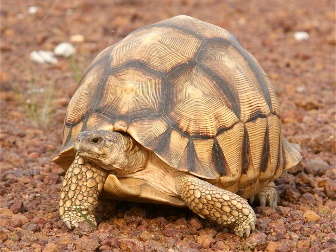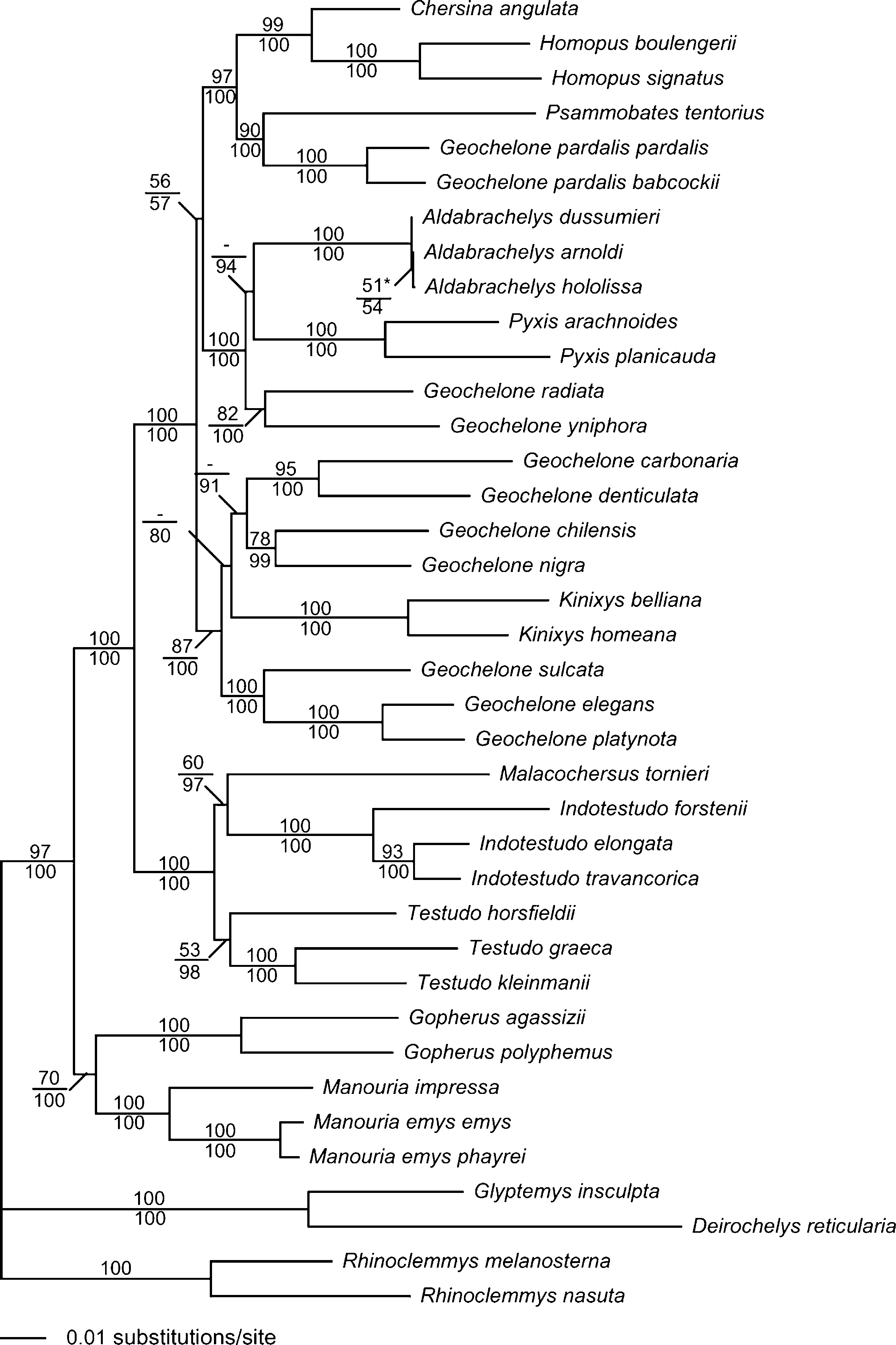
The plowshare tortoise, Astrochelys anaphora, is a critically endangered species found in Madagascar. It was listed as critically endangered in 2008. Other synonyms include Angonoka anaphora, Geochelone anaphora, and Testudo anaphora. The last remnants of this species estimated to be around 600 in number are found within the area of approximately 25 to 60 square kilometers. This is in northwestern Madagascar in Baly Bay. The surviving ones are divided into five subpopulations. Two groups are found east of the Andranomavo river while the remaining three groups are found west. The habitat they can survive in consists of mangrove swamps, savanna, and dry deciduous forest. It experiences distinct seasonal rainfall as its climate is tropical. The elevation of the habitable land is approximately 50 meters above sea level (Leuteritz and Pedrono, 2008).
Female tortoises are smaller and lighter than males. The average length and weight of the females are 370.1mm and 8.8kg respectively. The average length and weight of the male are 414.8mm and 10.3kg respectively. They feed on shrubs, forbs, and herbs which are found in the bamboos scrub especially in the open rocky areas. They can also feed on dead bamboo leaves. The tortoises reach sexual maturity when they are at least 15 years old. The mating period falls between mid-January and the end of May. The females lay an average of two clutches per season and a mean of three eggs per clutch. With a hatching success rate of 54 percent, a female produces at least four hatchlings during the season (Leuteritz and Pedrono, 2008).
Taxonomy
The plowshare is in the kingdom Animalia, phylum Chordata, class Reptilia, order Testudines, and family Testudinidae. The central species of Astrochelys anaphora is Testudo anaphora (Vaillant, 1885).
The current taxonomy matches the phylogenies. Fritz and Binnida-Edmonds (2007) describe that due to the morphological similarities between G. anaphora and G. radiata, they should be classified under the same genus of Astrochelys.
Phylogeny
In 2006, Le et al. had conducted a molecular phylogeny. The study aimed to produce a phylogeny of the family Testudinidae through the analysis of five molecular sets: three genes in the mitochondrial DNA and two genes in the nuclear DNA. Nuclear DNA i.e. Rag2 and Cmos had been utilized in previous molecular phylogenetic investigations. The data were analyzed using maximum parsimony, maximum likelihood, and Bayesian Analysis methods. The study determined the presence of three major clades. The clade where the plowshare falls was the largest. It was made up of five internal clades. It was found in the fifth consisting of Pyxis+ Aldabrachelys +Geochelone radiata and G. anaphora. There was a sister relationship between G. ynophora and G. radiata. The morphological similarity of the two species had been supported by previous studies. They both had keels on the supra-occipital crest. As the G. ynophora could not be placed in the genus Geochelone, Le et al. proposed a new genus of Angonoka.

Fritz and Binnida-Edmonds (2007) experimented to determine whether the allocation of G. ynophora in the genus Angonoka was justified. The data used in the determination of the phylogenetic relationships is genetic sequences, i.e., mitochondrial DNA: 12S ribosomal RNA, 16S ribosomal RNA, the gene coding for cytochrome b in the mitochondria, and nuclear DNA: Rag2 and Cmos. Morphological data was also used to analyze the species. The phylogenetic methods used to analyze the data included maximum likelihood, maximum parsimony, and Bayesian analysis. It was confirmed that G. gynophore needed to be removed from the genus Geochelone from the analysis of its sequences. It was instead to be classified under the genus Astrochelys. The Geochelone genus should be limited to G. elegans) should be restricted to G. elegans, G. platynotan, and G. sulcate. The first two species are found in South America. This study was based on the previous study by Le et al. (2006). In the previous study, G. radiata had been allocated to the genus Astrochelys and G. ynophora to the genus Angonoka. Fritz recommended that both species be classified under the genus Astrochelys due to their morphological similarities (Fritz and Binnida-Edmonds, 2007). They were both medium in size and their shells were highly domed.
Conservation
Habitat
The habitat of the plowshare has been destroyed due to human activities. Human beings have encroached into their habitats. As the population of the man rose, the demand for land grew. More forest land was cleared to create room for grazing and farming. This destroyed the habitat and resulted in the elimination of the various plants and vegetation that were a source of nutrition for the A. anaphora. The creation of natural firebreaks through the burning of vegetation on the savanna fringes also contributed to the destruction of the habitat. This resulted in the contraction of the population to the present limit of 60 square kilometers that supports their survival. The species was recognized as endangered and thus became protected under Madagascar law. In 1997, the Baby Bay area became gazetted as a national park. This prevented further encroachment of humans into the remaining lands supporting the species. The park has rangers, consisting of locally employed villagers, who watch out for possible fire outbreaks.
Invasive Species
The main invasive species included humans, cattle, and pigs. The African bush pig feeds on juveniles and the eggs of the reptile (Fishbeck, 2019). Humans sought more land for the expansion of their farming. The plowshare tortoises were also hunted for their meat by locals. As their numbers continued to dwindle, active poaching began as they became highly demanded in the Asian market. The critically endangered status of the animal has exposed it to further poaching due to its high price in the black market. The prevention of poaching is complicated by the proximity of the habitat to the sea hence easy access by poachers. The locally employed rangers also protect the tortoises from poaching. They also patrol the shoreline to identify any suspicious vessels. However, their work is complicated by the limited resources of the Madagascar government, the prevailing poverty in the surrounding areas, and the difficulty of patrolling (Kiester et al., 2013).
Population Growth
Population overgrowth is closely linked to the encroachment of human settlements into plowshare territory. Whenever humans settle in a place, they tend to utilize it for farming and livestock keeping. As their lives become more comfortable, their numbers start to swell due to reproduction. The higher population places a greater demand on the existing resources, making it imperative to expand the land under occupation. This is exemplified by the humans who set fire to the natural vegetation to create grazing land for their animals. The effects of population overgrowth were mitigated by the gazettement of the area as protected by the government. This prevents any human activity from being carried out which may harm the animals.
Overharvesting
Over a long period, the population of the plowshare tortoise has dwindled to critical levels. This was due to their uncontrolled hunting by locals for food over the past years. However, their current scarcity in the wild has created a lucrative market for them. Unscrupulous collectors are willing to pay at least five thousand dollars for an adult tortoise. The locals may resort to poaching due to the magnitude of funds that will be available to them. This can be prevented by employing the locals as rangers in the habitat. This enables them to earn a steady income while ensuring the safety of the animals. Some conservations in the country have marked the shells of their tortoises to prevent their capture as they will be easily recognizable in the international black market. Tortoises have also been fitted with radio devices to enable easy tracking of their locations and detect the conditions of their environment (“Ploughshare Tortoise Conservation,” n.d.).
Synthesis
The different kinds of literature are all in agreement that A. ynophora is a distinct species. This underlines the importance of ensuring the conservation of the tortoise. Failure to protect it will result in the extinction of an important reptilian species. As their numbers are already low and may fail to grow at a satisfactory rate, in-country captive breeding offers an avenue for ensuring their survival. The poached animals are trafficked to people all over the world. This necessitates a global approach which makes it illegal worldwide to deal with endangered animals. Finally, the creation of awareness is necessary, especially among the locals. This enables them to appreciate the value that the animals bring to their land and the precarious position the species is facing. Any approach to conservation should involve all stakeholders to ensure its success.
References
- Fishbeck, L. 2019. Astrochelys yniphora (Madagascan (Plowshare) Tortoise). Web.
- Fritz, U. and Bininda-Emonds, O. 2007. When genes meet nomenclature: Tortoise phylogeny and the shifting generic concepts of Testudo and Geochelone. Zoology 110: 298-307.
- Kiester, A.R., Mandimbihasina, A., Lewis, R., Goode, E., Juvik, J., Young, R., Blanck, T. 2013. Conservation of the Angonoka (Ploughshare Tortoise), Astrochelys yniphora. Chelonian Research Monographs Turtles on the Brink in Madagascar: Proceedings of Two Workshops on the Status, Conservation, and Biology of Malagasy Tortoises and Freshwater Turtles.:162–170.
- Le, M., Raxworthy, C., McCord, W. and Mertz, L. 2006. A molecular phylogeny of tortoises (Testudines: Testudinidae) based on mitochondrial and nuclear genes. Molecular Phylogenetics and Evolution 40: 517-531.
- Leuteritz, T. and Pedrono, M. 2008. (Madagascar Tortoise and Freshwater Turtle Red List Workshop) Astrochelys yniphora. The IUCN Red List of Threatened Species 2008: e.T9016A12950950.
- Ploughshare Tortoise Conservation. n.d. Web.